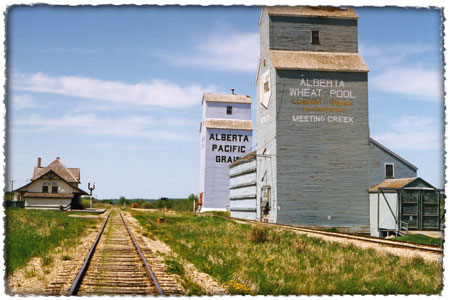The Prairies
Tuesday, March 11, 2008
Hudson's Bay Company Archives
Manitoba is home to one of the most important pieces of Canadian history, the HBC archives. Hudson's Bay Company (HBC) is one of the oldest companies in the world and helped to build Canada into a country. Providing a population of settlers from Europe they originally came here to trap and provide the highly popular beaver pelts to Europe. HBC played an important role in the settlement and urban development of western Canada. HBC was founded on 2 May 1670 when King Charles granted a charter to his cousin Prince Rupert and his associates.
Located in Winnipeg Manitoba the Hudson’s Bay Company Archives (HBCA) holds many textual records, photographs and architectural drawings. The Hudson's Bay Company (HBC) insisted on meticulous record-keeping and most of its records remained in its possession. The result is a documentary archive remarkable for its size - more than 3,000 linear metres - and its continuity. The earliest HBC record in the archives is a minute book dating from 1671, recording decisions made at the meetings of the HBC's Governor and Committee. With the exception of a four-year gap, all the minute books from 1671 to 1970 are in the HBCA. The photographic holdings of the Hudson's Bay Company Archives total approximately 130,000 images. The Hudson's Bay Company Archives has the largest holding of fur trade maps in North America. There are more than 12,000 maps, charts, plans and architectural drawings, dating between the years 1563 and about 1982.
http://www.gov.mb.ca/chc/archives/hbca/about/hbca.html
The Hudson's Bay Company Archives (HBCA) Library is a valuable research resource. It contains over 10,000 titles (books, articles, periodicals, videos and CD-ROMs) on the HBC, especially its fur trade; Aboriginal peoples of North America; and the history of western Canada, the USA and the Arctic. The library was enlarged considerably in the year 2000 by the acquisition of the library of The Beaver magazine. There is a significant rare book collection, which includes some of the personal library of fur trader Peter Fidler (1769-1822) and books from libraries maintained at posts such as York Factory.The library is accessible only in the Manitoba Archives Building. A partial catalogue is available online through the Library Information Portal. Photocopies of articles and portions of books can be sent to patrons, unless the physical condition of the book prevents photocopying.
Located in Winnipeg Manitoba the Hudson’s Bay Company Archives (HBCA) holds many textual records, photographs and architectural drawings. The Hudson's Bay Company (HBC) insisted on meticulous record-keeping and most of its records remained in its possession. The result is a documentary archive remarkable for its size - more than 3,000 linear metres - and its continuity. The earliest HBC record in the archives is a minute book dating from 1671, recording decisions made at the meetings of the HBC's Governor and Committee. With the exception of a four-year gap, all the minute books from 1671 to 1970 are in the HBCA. The photographic holdings of the Hudson's Bay Company Archives total approximately 130,000 images. The Hudson's Bay Company Archives has the largest holding of fur trade maps in North America. There are more than 12,000 maps, charts, plans and architectural drawings, dating between the years 1563 and about 1982.
http://www.gov.mb.ca/chc/archives/hbca/about/hbca.html
The Hudson's Bay Company Archives (HBCA) Library is a valuable research resource. It contains over 10,000 titles (books, articles, periodicals, videos and CD-ROMs) on the HBC, especially its fur trade; Aboriginal peoples of North America; and the history of western Canada, the USA and the Arctic. The library was enlarged considerably in the year 2000 by the acquisition of the library of The Beaver magazine. There is a significant rare book collection, which includes some of the personal library of fur trader Peter Fidler (1769-1822) and books from libraries maintained at posts such as York Factory.The library is accessible only in the Manitoba Archives Building. A partial catalogue is available online through the Library Information Portal. Photocopies of articles and portions of books can be sent to patrons, unless the physical condition of the book prevents photocopying.
Fort Battleford National Historic Site
Fort Battleford is located at the junction of the North Saskatchewan and Battle rivers, northwest of present-day Saskatoon. The fort marks several major advancements and events of the Canadian military and government over the history of white settlement throughout the Prairies. It also attempts to recreate the Aboriginal history within the area that often is overlooked and mythologized. The preservation of Fort Battleford as a National Historic Site is one of important contribution to Canadian culture and  nationalism as a whole because of its association with the early conflicts of settling and 'civilizing' Western Canada. In beginning to interpret its importance as an official Heritage Site, a brief understanding of its historical time line is necessary followed by a look at the proposals presented in favour of its creation.
nationalism as a whole because of its association with the early conflicts of settling and 'civilizing' Western Canada. In beginning to interpret its importance as an official Heritage Site, a brief understanding of its historical time line is necessary followed by a look at the proposals presented in favour of its creation.
 nationalism as a whole because of its association with the early conflicts of settling and 'civilizing' Western Canada. In beginning to interpret its importance as an official Heritage Site, a brief understanding of its historical time line is necessary followed by a look at the proposals presented in favour of its creation.
nationalism as a whole because of its association with the early conflicts of settling and 'civilizing' Western Canada. In beginning to interpret its importance as an official Heritage Site, a brief understanding of its historical time line is necessary followed by a look at the proposals presented in favour of its creation. Battleford was established as a military barrack for the North West Mounted Police and the first capital of the former Northwest
 Territories in 1876. Prior to confederation, the region of the prairies was owned by the Hudson's Bay Company and few non-native settlements had been established west of Manitoba boarders. The Canadian Dominion was pushing for control over the nation from Atlantic to Pacific and the Northwest Territories stood in the way as a land which required registered settlement and good governing. In the eyes of the elite, a fort for the NWMP suited best for initiating the push of the Frontier westward. This action was performed in most part in hopes to break the 'savagery' of the existing Native tribes and peacefully incorporate them into civilized society. In 1885, mounting fears of physical conflict had put both the Métis/Native peoples and the NWMP settlements into a relationship with a thin breaking point. Members of the local tribes had
Territories in 1876. Prior to confederation, the region of the prairies was owned by the Hudson's Bay Company and few non-native settlements had been established west of Manitoba boarders. The Canadian Dominion was pushing for control over the nation from Atlantic to Pacific and the Northwest Territories stood in the way as a land which required registered settlement and good governing. In the eyes of the elite, a fort for the NWMP suited best for initiating the push of the Frontier westward. This action was performed in most part in hopes to break the 'savagery' of the existing Native tribes and peacefully incorporate them into civilized society. In 1885, mounting fears of physical conflict had put both the Métis/Native peoples and the NWMP settlements into a relationship with a thin breaking point. Members of the local tribes had  gathered under Chief Poundmaker to confront the local Native Agent at the fort in order to express their concerns for the intrusion of the Federal government. Simultaneously, the police stationed at the fort had received several escaped captives of a travelling family bringing news of the murder of other family members by a Cree tribe. With tensions already high, Battleford opened as a refuge for settlers and stood ready in expectance of an attack from the arriving tribe members. With tensions high conflict broke out at nearby Cut Knife Hill, which resulted in the trial and execution of eight native prisoners back in Battleford.
gathered under Chief Poundmaker to confront the local Native Agent at the fort in order to express their concerns for the intrusion of the Federal government. Simultaneously, the police stationed at the fort had received several escaped captives of a travelling family bringing news of the murder of other family members by a Cree tribe. With tensions already high, Battleford opened as a refuge for settlers and stood ready in expectance of an attack from the arriving tribe members. With tensions high conflict broke out at nearby Cut Knife Hill, which resulted in the trial and execution of eight native prisoners back in Battleford. The 'metropolitan' standpoint, which Walter Hildebrandt opposes in his work Views from Fort Battleford, is one which is based on the glorification of NWMP and western settlement. The presentations and information on display at the Heritage site today attempt to enforce equal attention to the viewpoints of both parties in the face of the conflict which broke out during the Rebellions/Resistances of that year. The period from 1885 until the forts closure in 1924 represents a notable turning-point in federal government action. During this period the federal government saw the First Nations and Métis effectively as obstacles to the grand vision of confederation and referenced the Northwest Rebellions as a need to further assimilate or seclude their populations. Initially, the NWMP were recommended to enforce the terms of the Indian Act more efficiently. Significant amendments were made to restrict religious ceremonies such as potlatches and outline actions for removal of reserve land in 1885 and 1905 respectively to insure safety for arriving immigrants.
Upon the closure of the operational fort in 1924, the site was designated with historical recognition by the Historic Sites and Monuments Board of Canada (HSMBC) and commemorated with the iconic Heritage Site
 bronze plaque. The story portrayed during its opening years focused mainly on the metropolitan depiction common of the time period, holding little truth for First Nation representations. In the late 1940s, significant demand led Campbell Innes and several other scholars to insist that the HSMBC incorporate the First Nations voice into the historic site. Today, the displays and tours are geared to present a truthful representation of the events specific to Battleford in order to allow visitors a chance to relive the experiences as they had happened many years ago. Furthermore, it does not stand alone as the only educational institution in the region, sharing the town with the Western Development Museum and several other tourist information attractions. Together these establishments hope to educate the public by creating meaningful relationships with the past and encouraging nationalism.
bronze plaque. The story portrayed during its opening years focused mainly on the metropolitan depiction common of the time period, holding little truth for First Nation representations. In the late 1940s, significant demand led Campbell Innes and several other scholars to insist that the HSMBC incorporate the First Nations voice into the historic site. Today, the displays and tours are geared to present a truthful representation of the events specific to Battleford in order to allow visitors a chance to relive the experiences as they had happened many years ago. Furthermore, it does not stand alone as the only educational institution in the region, sharing the town with the Western Development Museum and several other tourist information attractions. Together these establishments hope to educate the public by creating meaningful relationships with the past and encouraging nationalism. Winnipeg Railway Station: Manitoba Provincial Heritage Site #76

What is the purpose of a National Historic Site?
-physical landmark of events and places presenting the history of diversity in Canada, as not to be lost into the generic British cultural past
What does the former CPR Railway Station (Winnipeg Railway Station (Canadian Pacific) National Historic Site of Canada) represent?
“The magnificence of this former CPR station in Winnipeg reflected the extraordinary prosperity of Winnipeg: the gateway to the Prairies. It also echoed the boundless optimism of those who passed through its great halls. Waves of newcomers, each with visions of a better life, and so they still come today. Each wave introduces new ways of doing things – new dreams and new visions. The challenge for people who came before is how to accommodate these new dreams and visions.”
http://www2.parkscanada.gc.ca/apprendre-learn/prof/racines-roots/itm4-video/continent_e.asp
“The former Canadian Pacific Railway (CPR) Station is one of the province's most notable sites. Between 1904, when the building was completed, and 1914, when the great waves of immigration were dwindling, thousands of Prairie homesteaders passed through its grand portico.
The station was designed by the renowned Montreal firm of Edward and W.S. Maxwell. At the Winnipeg CPR Station, the Maxwell brothers created an early Canadian example of the Beaux-Arts Classical style. That style was very popular throughout Europe and North America for the construction of large public buildings. The huge columns of the station's portico and the richly ornamented façade are hallmarks of the style. The great size of the building, and the choice of style, reflected the CPR's prosperity and ex-pectations for an illustrious future for the West.”
http://www.gov.mb.ca/chc/hrb/prov/p076.html
This site is unique because it represents the cultural diversity that existed because of immigration in to the West. ‘Most designated heritage sites preserved in Manitoba either have a strong association with the Hudson’s Bay Company or are associated with the stronghold Ottawa and the military were able to assert on the West.(Ricketts, 11)’
In the 19th century Canada population was predominantly British and French. It was essentially a variant of British culture where the majority of the population was white, protestant, anglo-saxon, and English speaking. Canada’s west was largely unsettled. The Canadian government saw settling the west as synonymous with economic success for the country at large. Sir John A. MacDonald passed the Dominion Lands Act in 1872 that would provide settlers with 160 acres of land in the west for a small $10 fee. “Macdonald’s governments opened the Western prairies for settlement by making treaties with aboriginal peoples, surveying the land and offering homesteads, and creating the North-West Mounted Police to maintain law and order.” Great Britain was the first target of the Dominion Lands Act to settle the west but the invitation was extended to a variety of Northern and Eastern Europeans. The goal of the Prime-Minister was to settle the west with a largely homogeneous population. Those who settled the west around the turn of the century were Irish, German, Russian, Scandinavian, and Icelandic.
This site is unique because it doesn’t represent the greater British culture that existed, especially in central Canada and the East, but the great variety of immigrants who co-existed and eventually assimilated.
http://www.primeministers.ca/macdonald/issues.php
Recommended Reading
Knowles, Valerie. Strangers at our Gates: Canadian Immigration and Immigration Policy, 1540-1997. (Toronto: Dundurn, 1997).
Wednesday, February 20, 2008
Subscribe to:
Posts (Atom)




















